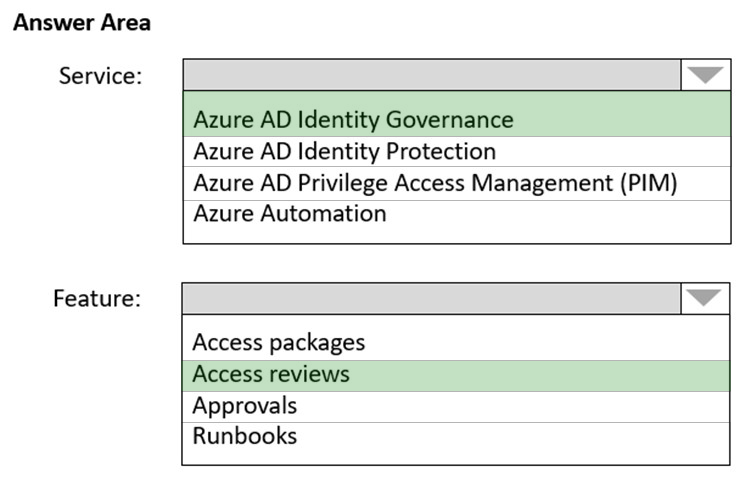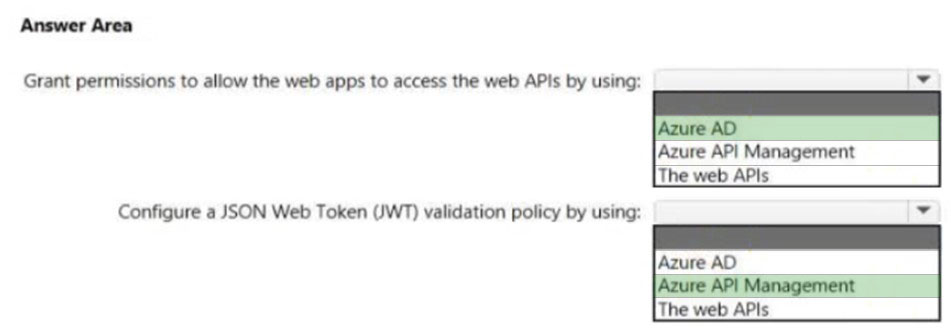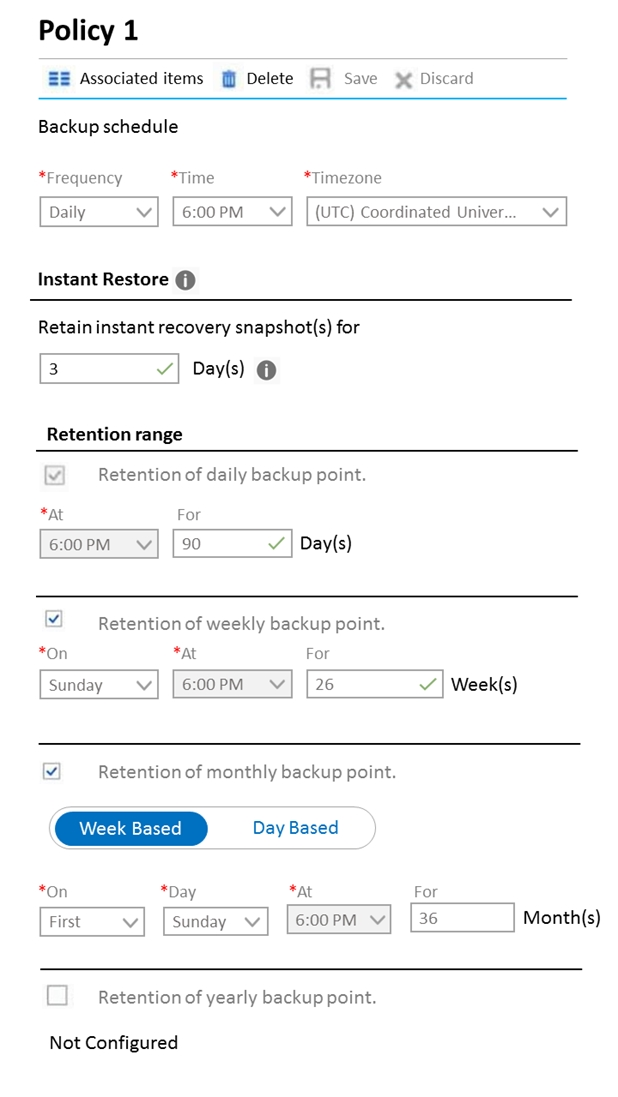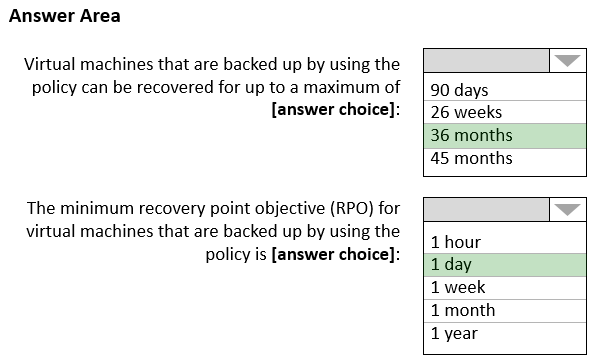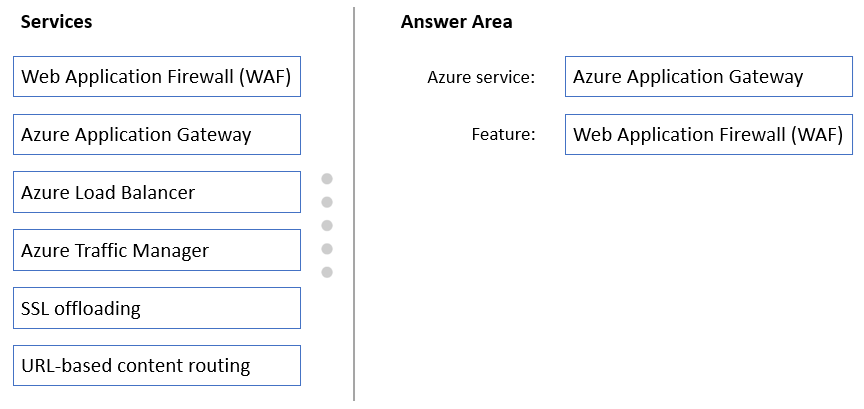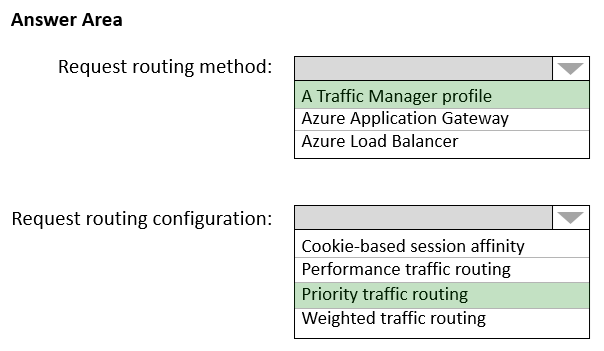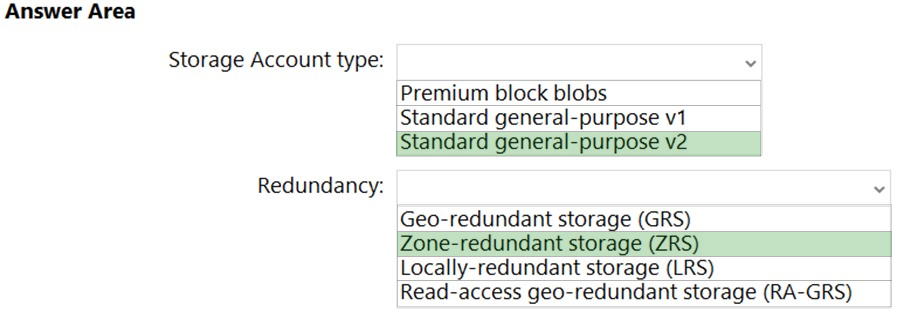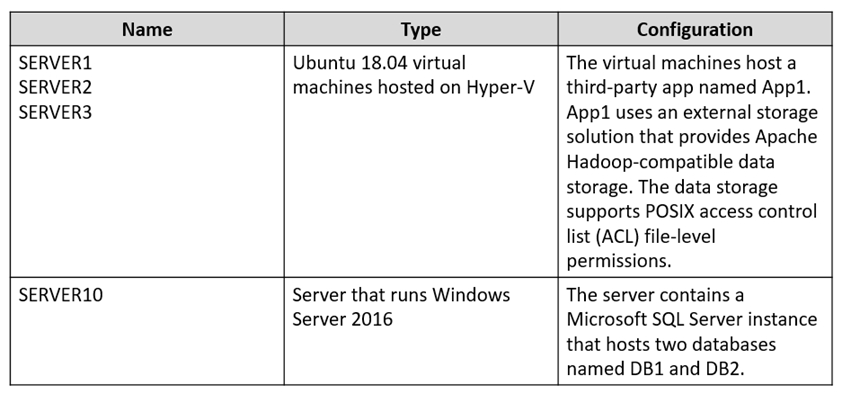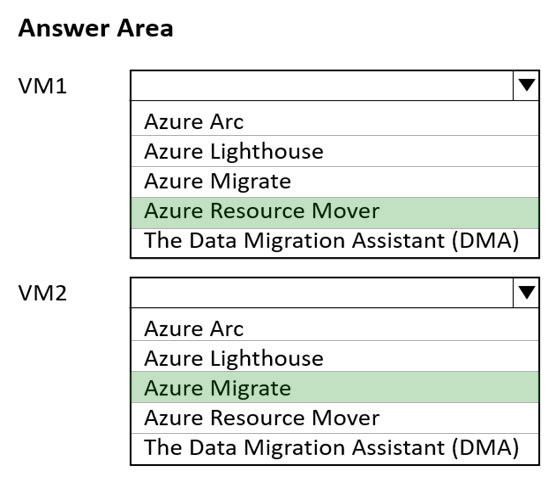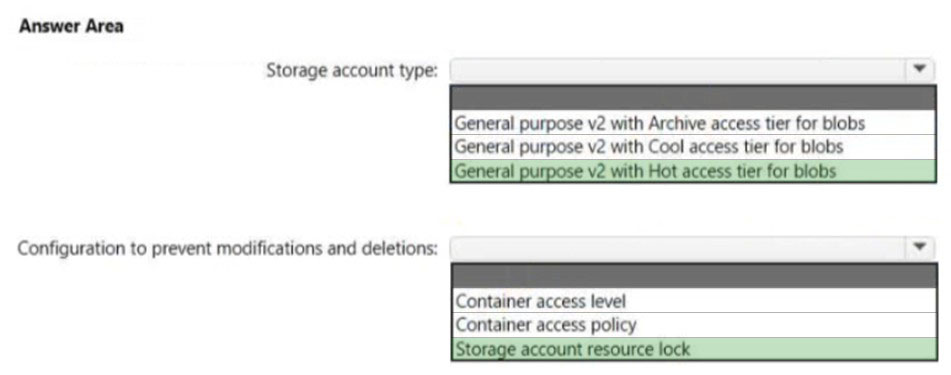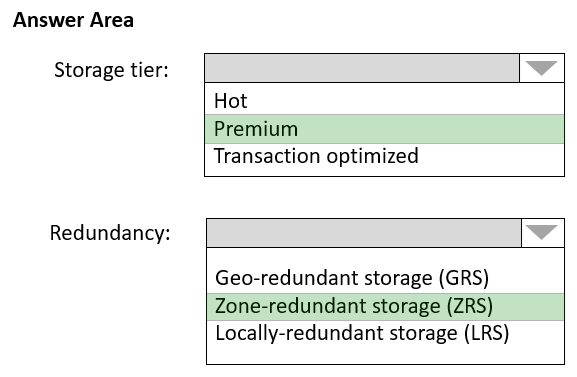AZ-305 Mock Test Free – 50 Realistic Questions to Prepare with Confidence.
Getting ready for your AZ-305 certification exam? Start your preparation the smart way with our AZ-305 Mock Test Free – a carefully crafted set of 50 realistic, exam-style questions to help you practice effectively and boost your confidence.
Using a mock test free for AZ-305 exam is one of the best ways to:
- Familiarize yourself with the actual exam format and question style
- Identify areas where you need more review
- Strengthen your time management and test-taking strategy
Below, you will find 50 free questions from our AZ-305 Mock Test Free resource. These questions are structured to reflect the real exam’s difficulty and content areas, helping you assess your readiness accurately.
Overview -
Contoso, Ltd. is a research company that has a main office in Montreal.
Existing Environment: Technical Environment
The on-premises network contains a single Active Directory domain named contoso.com.
Contoso has a single Azure subscription.
Existing Environment: Business Partnerships
Contoso has a business partnership with Fabrikam, Inc. Fabrikam users access some Contoso applications over the internet by using Azure Active Directory
(Azure AD) guest accounts.
Requirements: Planned Changes -
Contoso plans to deploy two applications named App1 and App2 to Azure.
Requirements: App1 -
App1 will be a Python web app hosted in Azure App Service that requires a Linux runtime. Users from Contoso and Fabrikam will access App1.
App1 will access several services that require third-party credentials and access strings. The credentials and access strings are stored in Azure Key Vault.
App1 will have six instances: three in the East US Azure region and three in the West Europe Azure region.
App1 has the following data requirements:
Each instance will write data to a data store in the same availability zone as the instance.
Data written by any App1 instance must be visible to all App1 instances.
App1 will only be accessible from the internet. App1 has the following connection requirements:
Connections to App1 must pass through a web application firewall (WAF).
Connections to App1 must be active-active load balanced between instances.
All connections to App1 from North America must be directed to the East US region. All other connections must be directed to the West Europe region.
Every hour, you will run a maintenance task by invoking a PowerShell script that copies files from all the App1 instances. The PowerShell script will run from a central location.
Requirements: App2 -
App2 will be a .NET app hosted in App Service that requires a Windows runtime. App2 has the following file storage requirements:
Save files to an Azure Storage account.
Replicate files to an on-premises location.
Ensure that on-premises clients can read the files over the LAN by using the SMB protocol.
You need to monitor App2 to analyze how long it takes to perform different transactions within the application. The solution must not require changes to the application code.
Application Development Requirements
Application developers will constantly develop new versions of App1 and App2. The development process must meet the following requirements:
A staging instance of a new application version must be deployed to the application host before the new version is used in production.
After testing the new version, the staging version of the application will replace the production version.
The switch to the new application version from staging to production must occur without any downtime of the application.
Identity Requirements -
Contoso identifies the following requirements for managing Fabrikam access to resources:
Every month, an account manager at Fabrikam must review which Fabrikam users have access permissions to App1. Accounts that no longer need permissions must be removed as guests.
The solution must minimize development effort.
Security Requirement -
All secrets used by Azure services must be stored in Azure Key Vault.
Services that require credentials must have the credentials tied to the service instance. The credentials must NOT be shared between services.
HOTSPOT -
What should you implement to meet the identity requirements? To answer, select the appropriate options in the answer area.
NOTE: Each correct selection is worth one point.
Hot Area:
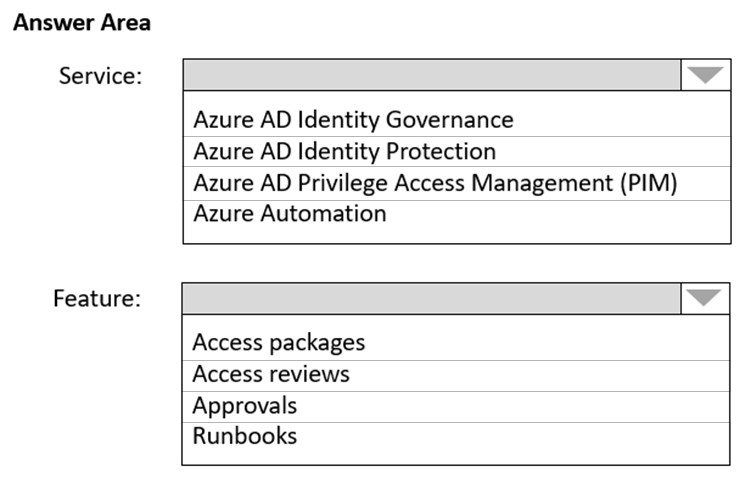
You need to design a highly available Azure SQL database that meets the following requirements:
✑ Failover between replicas of the database must occur without any data loss.
✑ The database must remain available in the event of a zone outage.
✑ Costs must be minimized.
Which deployment option should you use?A. Azure SQL Managed Instance Business Critical
B. Azure SQL Database Premium
C. Azure SQL Database Basic
D. Azure SQL Managed Instance General Purpose
You are developing a sales application that will contain several Azure cloud services and handle different components of a transaction. Different cloud services will process customer orders, billing, payment, inventory, and shipping.
You need to recommend a solution to enable the cloud services to asynchronously communicate transaction information by using XML messages.
What should you include in the recommendation?A. Azure Service Bus
B. Azure Data Lake
C. Azure Application Gateway
D. Azure Notification Hubs
Note: This question is part of a series of questions that present the same scenario. Each question in the series contains a unique solution that might meet the stated goals. Some question sets might have more than one correct solution, while others might not have a correct solution.
After you answer a question in this section, you will NOT be able to return to it. As a result, these questions will not appear in the review screen.
Your company deploys several virtual machines on-premises and to Azure. ExpressRoute is deployed and configured for on-premises to Azure connectivity.
Several virtual machines exhibit network connectivity issues.
You need to analyze the network traffic to identify whether packets are being allowed or denied to the virtual machines.
Solution: Use Azure Network Watcher to run IP flow verify to analyze the network traffic.
Does this meet the goal?A. Yes
B. No
You are designing an application that will aggregate content for users.
You need to recommend a database solution for the application. The solution must meet the following requirements:
• Support SQL commands.
• Support multi-master writes.
• Guarantee low latency read operations.
What should you include in the recommendation?A. Azure Cosmos DB for NoSQL
B. Azure SQL Database that uses active geo-replication
C. Azure SQL Database Hyperscale
D. Azure Cosmos DB for PostgreSQL
You need to design a highly available Azure SQL database that meets the following requirements:
• Failover between replicas of the database must occur without any data loss.
• The database must remain available in the event of a zone outage.
• Costs must be minimized.
Which deployment option should you use?A. Azure SQL Database Serverless
B. Azure SQL Managed Instance General Purpose
C. Azure SQL Database Basic
D. Azure SQL Database Business Critical
DRAG DROP
-
You have an on-premises datacenter named Site1. Site1 contains a VMware vSphere cluster named Cluster1 that hosts 100 virtual machines. Cluster1 is managed by using VMware vCenter.
You have an Azure subscription named Sub1.
You plan to migrate the virtual machines from Cluster1 to Sub1.
You need to identify which resources are required to run the virtual machines in Azure. The solution must minimize administrative effort.
What should you configure? To answer, drag the appropriate resources to the correct targets. Each resource may be used once, more than once, or not at all. You may need to drag the split bar between panes or scroll to view content.
NOTE: Each correct selection is worth one point.

You have an Azure subscription.
You need to deploy an Azure Kubernetes Service (AKS) solution that will use Windows Server 2019 nodes. The solution must meet the following requirements:
• Minimize the time it takes to provision compute resources during scale-out operations.
• Support autoscaling of Windows Server containers.
Which scaling option should you recommend?A. horizontal pod autoscaler
B. Virtual nodes
C. Kubernetes version 1.20.2 or newer
D. cluster autoscaler
You have an Azure subscription that contains a storage account.
An application sometimes writes duplicate files to the storage account.
You have a PowerShell script that identifies and deletes duplicate files in the storage account. Currently, the script is run manually after approval from the operations manager.
You need to recommend a serverless solution that performs the following actions:
✑ Runs the script once an hour to identify whether duplicate files exist
✑ Sends an email notification to the operations manager requesting approval to delete the duplicate files
✑ Processes an email response from the operations manager specifying whether the deletion was approved
✑ Runs the script if the deletion was approved
What should you include in the recommendation?A. Azure Logic Apps and Azure Event Grid
B. Azure Logic Apps and Azure Functions
C. Azure Pipelines and Azure Service Fabric
D. Azure Functions and Azure Batch
DRAG DROP
-
You have an Azure AD tenant that contains an administrative unit named MarketingAU. MarketingAU contains 100 users.
You create two users named User1 and User2.
You need to ensure that the users can perform the following actions in MarketingAU:
• User1 must be able to create user accounts.
• User2 must be able to reset user passwords.
Which role should you assign to each user? To answer, drag the appropriate roles to the correct users. Each role may be used once, more than once, or not at all. You may need to drag the split bar between panes or scroll to view content.
NOTE: Each correct selection is worth one point.

You have 100 servers that run Windows Server 2012 R2 and host Microsoft SQL Server 2014 instances. The instances host databases that have the following characteristics:
✑ Stored procedures are implemented by using CLR.
✑ The largest database is currently 3 TB. None of the databases will ever exceed 4 TB.
You plan to move all the data from SQL Server to Azure.
You need to recommend a service to host the databases. The solution must meet the following requirements:
✑ Whenever possible, minimize management overhead for the migrated databases.
✑ Ensure that users can authenticate by using Azure Active Directory (Azure AD) credentials.
✑ Minimize the number of database changes required to facilitate the migration.
What should you include in the recommendation?A. Azure SQL Database elastic pools
B. Azure SQL Managed Instance
C. Azure SQL Database single databases
D. SQL Server 2016 on Azure virtual machines
You plan to use an Azure Storage account to store data assets.
You need to recommend a solution that meets the following requirements:
• Supports immutable storage
• Disables anonymous access to the storage account
• Supports access control list (ACL)-based Azure AD permissions
What should you include in the recommendation?A. Azure Files
B. Azure Data Lake Storage
C. Azure NetApp Files
D. Azure Blob Storage
Overview -
Contoso, Ltd. is a research company that has a main office in Montreal.
Existing Environment -
Technical Environment -
The on-premises network contains a single Active Directory domain named contoso.com.
Contoso has a single Azure subscription.
Business Partnerships -
Contoso has a business partnership with Fabrikam, Inc. Fabrikam users access some Contoso applications over the internet by using Azure Active Directory
(Azure AD) guest accounts.
Requirements -
Planned Changes -
Contoso plans to deploy two applications named App1 and App2 to Azure.
App1 -
App1 will be a Python web app hosted in Azure App Service that requires a Linux runtime. Users from Contoso and Fabrikam will access App1.
App1 will access several services that require third-party credentials and access strings. The credentials and access strings are stored in Azure Key Vault.
App1 will have six instances: three in the East US Azure region and three in the West Europe Azure region.
App1 has the following data requirements:
Each instance will write data to a data store in the same availability zone as the instance.
Data written by any App1 instance must be visible to all App1 instances.
App1 will only be accessible from the internet. App1 has the following connection requirements:
Connections to App1 must pass through a web application firewall (WAF).
Connections to App1 must be active-active load balanced between instances.
All connections to App1 from North America must be directed to the East US region. All other connections must be directed to the West Europe region.
Every hour, you will run a maintenance task by invoking a PowerShell script that copies files from all the App1 instances. The PowerShell script will run from a central location.
App2 -
App2 will be a .NET app hosted in App Service that requires a Windows runtime. App2 has the following file storage requirements:
Save files to an Azure Storage account.
Replicate files to an on-premises location.
Ensure that on-premises clients can read the files over the LAN by using the SMB protocol.
You need to monitor App2 to analyze how long it takes to perform different transactions within the application. The solution must not require changes to the application code.
Application Development Requirements
Application developers will constantly develop new versions of App1 and App2. The development process must meet the following requirements:
A staging instance of a new application version must be deployed to the application host before the new version is used in production.
After testing the new version, the staging version of the application will replace the production version.
The switch to the new application version from staging to production must occur without any downtime of the application.
Identity Requirements -
Contoso identifies the following requirements for managing Fabrikam access to resources:
Every month, an account manager at Fabrikam must review which Fabrikam users have access permissions to App1. Accounts that no longer need permissions must be removed as guests.
The solution must minimize development effort.
Security Requirement -
All secrets used by Azure services must be stored in Azure Key Vault.
Services that require credentials must have the credentials tied to the service instance. The credentials must NOT be shared between services.
You need to recommend a solution for the App1 maintenance task. The solution must minimize costs.
What should you include in the recommendation?A. an Azure logic app
B. an Azure function
C. an Azure virtual machine
D. an App Service WebJob
HOTSPOT
-
You have an Azure subscription that contains 50 Azure SQL databases.
You create an Azure Resource Manager (ARM) template named Template1 that enables Transparent Data Encryption (TDE).
You need to create an Azure Policy definition named Policy1 that will use Template1 to enable TDE for any noncompliant Azure SQL databases.
How should you configure Policy1? To answer, select the appropriate options in the answer area.
NOTE: Each correct selection is worth one point.

You have an Azure subscription.
You need to deploy an Azure Kubernetes Service (AKS) solution that will use Windows Server 2019 nodes. The solution must meet the following requirements:
✑ Minimize the time it takes to provision compute resources during scale-out operations.
✑ Support autoscaling of Windows Server containers.
Which scaling option should you recommend?A. Kubernetes version 1.20.2 or newer
B. Virtual nodes with Virtual Kubelet ACI
C. cluster autoscaler
D. horizontal pod autoscaler
Overview -
Contoso, Ltd. is a research company that has a main office in Montreal.
Existing Environment: Technical Environment
The on-premises network contains a single Active Directory domain named contoso.com.
Contoso has a single Azure subscription.
Existing Environment: Business Partnerships
Contoso has a business partnership with Fabrikam, Inc. Fabrikam users access some Contoso applications over the internet by using Azure Active Directory
(Azure AD) guest accounts.
Requirements: Planned Changes -
Contoso plans to deploy two applications named App1 and App2 to Azure.
Requirements: App1 -
App1 will be a Python web app hosted in Azure App Service that requires a Linux runtime. Users from Contoso and Fabrikam will access App1.
App1 will access several services that require third-party credentials and access strings. The credentials and access strings are stored in Azure Key Vault.
App1 will have six instances: three in the East US Azure region and three in the West Europe Azure region.
App1 has the following data requirements:
Each instance will write data to a data store in the same availability zone as the instance.
Data written by any App1 instance must be visible to all App1 instances.
App1 will only be accessible from the internet. App1 has the following connection requirements:
Connections to App1 must pass through a web application firewall (WAF).
Connections to App1 must be active-active load balanced between instances.
All connections to App1 from North America must be directed to the East US region. All other connections must be directed to the West Europe region.
Every hour, you will run a maintenance task by invoking a PowerShell script that copies files from all the App1 instances. The PowerShell script will run from a central location.
Requirements: App2 -
App2 will be a .NET app hosted in App Service that requires a Windows runtime. App2 has the following file storage requirements:
Save files to an Azure Storage account.
Replicate files to an on-premises location.
Ensure that on-premises clients can read the files over the LAN by using the SMB protocol.
You need to monitor App2 to analyze how long it takes to perform different transactions within the application. The solution must not require changes to the application code.
Application Development Requirements
Application developers will constantly develop new versions of App1 and App2. The development process must meet the following requirements:
A staging instance of a new application version must be deployed to the application host before the new version is used in production.
After testing the new version, the staging version of the application will replace the production version.
The switch to the new application version from staging to production must occur without any downtime of the application.
Identity Requirements -
Contoso identifies the following requirements for managing Fabrikam access to resources:
Every month, an account manager at Fabrikam must review which Fabrikam users have access permissions to App1. Accounts that no longer need permissions must be removed as guests.
The solution must minimize development effort.
Security Requirement -
All secrets used by Azure services must be stored in Azure Key Vault.
Services that require credentials must have the credentials tied to the service instance. The credentials must NOT be shared between services.
You need to recommend a solution that meets the data requirements for App1.
What should you recommend deploying to each availability zone that contains an instance of App1?A. an Azure Cosmos DB that uses multi-region writes
B. an Azure Data Lake store that uses geo-zone-redundant storage (GZRS)
C. an Azure Storage account that uses geo-zone-redundant storage (GZRS)
You are designing a microservices architecture that will support a web application.
The solution must meet the following requirements:
✑ Deploy the solution on-premises and to Azure.
Support low-latency and hyper-scale operations.
✑ Allow independent upgrades to each microservice.
✑ Set policies for performing automatic repairs to the microservices.
You need to recommend a technology.
What should you recommend?A. Azure Container Instance
B. Azure Logic App
C. Azure Service Fabric
D. Azure virtual machine scale set
HOTSPOT -
Your company has 20 web APIs that were developed in-house.
The company is developing 10 web apps that will use the web APIs. The web apps and the APIs are registered in the company s Azure Active Directory (Azure
AD) tenant. The web APIs are published by using Azure API Management.
You need to recommend a solution to block unauthorized requests originating from the web apps from reaching the web APIs. The solution must meet the following requirements:
✑ Use Azure AD-generated claims.
Minimize configuration and management effort.
What should you include in the recommendation? To answer, select the appropriate options in the answer area.
NOTE: Each correct selection is worth one point.
Hot Area:
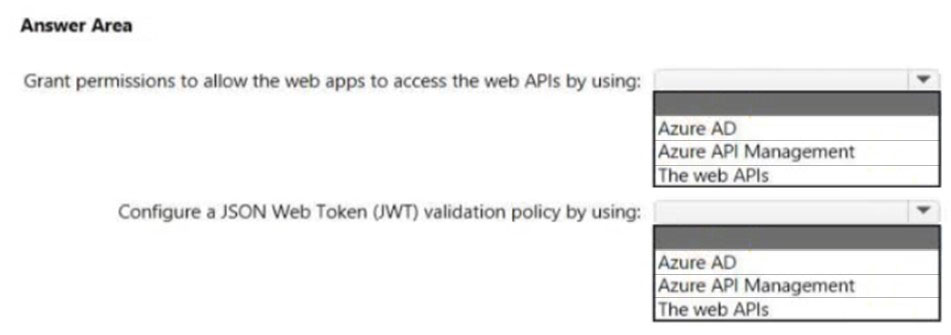
You need to design a highly available Azure SQL database that meets the following requirements:
✑ Failover between replicas of the database must occur without any data loss.
✑ The database must remain available in the event of a zone outage.
✑ Costs must be minimized.
Which deployment option should you use?A. Azure SQL Database Hyperscale
B. Azure SQL Database Premium
C. Azure SQL Database Basic
D. Azure SQL Managed Instance General Purpose
You need to recommend a solution to generate a monthly report of all the new Azure Resource Manager (ARM) resource deployments in your Azure subscription.
What should you include in the recommendation?A. Application Insights
B. Azure Analysis Services
C. Azure Advisor
D. Azure Activity Log
You need to design a solution that will execute custom C# code in response to an event routed to Azure Event Grid. The solution must meet the following requirements:
✑ The executed code must be able to access the private IP address of a Microsoft SQL Server instance that runs on an Azure virtual machine.
✑ Costs must be minimized.
What should you include in the solution?A. Azure Logic Apps in the Consumption plan
B. Azure Functions in the Premium plan
C. Azure Functions in the Consumption plan
D. Azure Logic Apps in the integrated service environment
You are designing an application that will be hosted in Azure.
The application will host video files that range from 50 MB to 12 GB. The application will use certificate-based authentication and will be available to users on the internet.
You need to recommend a storage option for the video files. The solution must provide the fastest read performance and must minimize storage costs.
What should you recommend?A. Azure Files
B. Azure Data Lake Storage Gen2
C. Azure Blob Storage
D. Azure SQL Database
Note: This question is part of a series of questions that present the same scenario. Each question in the series contains a unique solution that might meet the stated goals. Some question sets might have more than one correct solution, while others might not have a correct solution.
After you answer a question in this section, you will NOT be able to return to it. As a result, these questions will not appear in the review screen.
You plan to deploy multiple instances of an Azure web app across several Azure regions.
You need to design an access solution for the app. The solution must meet the following replication requirements:
✑ Support rate limiting.
✑ Balance requests between all instances.
✑ Ensure that users can access the app in the event of a regional outage.
Solution: You use Azure Front Door to provide access to the app.
Does this meet the goal?A. Yes
B. No
You have an Azure subscription that contains the resources shown in the following table.
You need to recommend a load balancing solution that will distribute incoming traffic for VMSS1 across NVA1 and NVA2. The solution must minimize administrative effort.
What should you include in the recommendation?A. Gateway Load Balancer
B. Azure Front Door
C. Azure Application Gateway
D. Azure Traffic Manager
HOTSPOT
-
You have an Azure subscription named Sub1 that is linked to an Azure AD tenant named contoso.com.
You plan to implement two ASP.NET Core apps named App1 and App2 that will be deployed to 100 virtual machines in Sub1. Users will sign in to App1 and App2 by using their contoso.com credentials.
App1 requires read permissions to access the calendar of the signed-in user. App2 requires write permissions to access the calendar of the signed-in user.
You need to recommend an authentication and authorization solution for the apps. The solution must meet the following requirements:
• Use the principle of least privilege.
• Minimize administrative effort.
What should you include in the recommendation? To answer, select the appropriate options in the answer area.
NOTE: Each correct selection is worth one point.

HOTSPOT -
You plan to deploy the backup policy shown in the following exhibit.
Use the drop-down menus to select the answer choice that completes each statement based on the information presented in the graphic.
NOTE: Each correct selection is worth one point.
Hot Area:
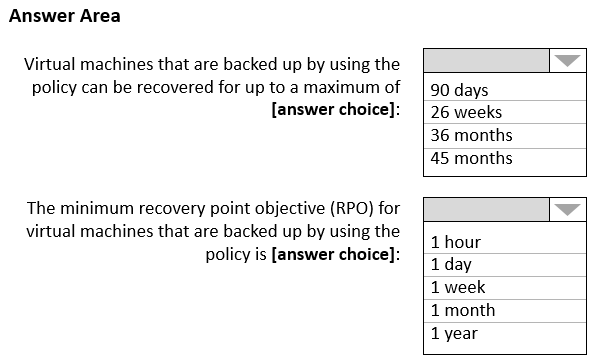
DRAG DROP -
You are designing a virtual machine that will run Microsoft SQL Server and contain two data disks. The first data disk will store log files, and the second data disk will store data. Both disks are P40 managed disks.
You need to recommend a host caching method for each disk. The method must provide the best overall performance for the virtual machine while preserving the integrity of the SQL data and logs.
Which host caching method should you recommend for each disk? To answer, drag the appropriate methods to the correct disks. Each method may be used once, more than once, or not at all. You may need to drag the split bar between panes or scroll to view content.
NOTE: Each correct selection is worth one point.
Select and Place:
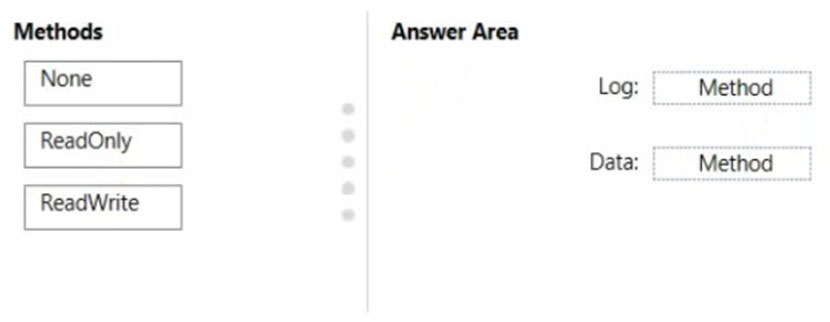
DRAG DROP -
Your company has an existing web app that runs on Azure virtual machines.
You need to ensure that the app is protected from SQL injection attempts and uses a layer-7 load balancer. The solution must minimize disruptions to the code of the app.
What should you recommend? To answer, drag the appropriate services to the correct targets. Each service may be used once, more than once, or not at all. You may need to drag the split bar between panes or scroll to view content.
NOTE: Each correct selection is worth one point.
Select and Place:
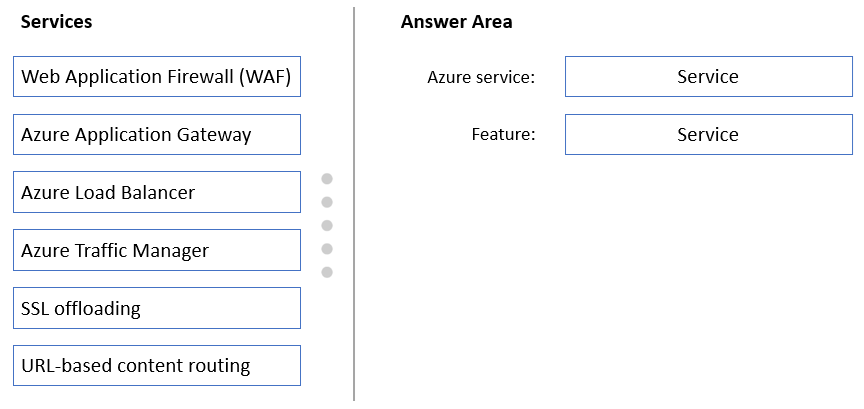
You are designing an app that will include two components. The components will communicate by sending messages via a queue.
You need to recommend a solution to process the messages by using a First in, First out (FIFO) pattern.
What should you include in the recommendation?A. storage queues with a custom metadata setting
B. Azure Service Bus queues with partitioning enabled
C. Azure Service Bus queues with sessions enabled
D. storage queues with a stored access policy
You have an Azure subscription that contains 10 web apps. The apps are integrated with Azure AD and are accessed by users on different project teams.
The users frequently move between projects.
You need to recommend an access management solution for the web apps. The solution must meet the following requirements:
• The users must only have access to the app of the project to which they are assigned currently.
• Project managers must verify which users have access to their project’s app and remove users that are no longer assigned to their project.
• Once every 30 days, the project managers must be prompted automatically to verify which users are assigned to their projects.
What should you include in the recommendation?A. Azure AD Identity Protection
B. Microsoft Defender for Identity
C. Microsoft Entra Permissions Management
D. Azure AD Identity Governance
You have an Azure subscription that contains two applications named App1 and App2. App1 is a sales processing application. When a transaction in App1 requires shipping, a message is added to an Azure Storage account queue, and then App2 listens to the queue for relevant transactions.
In the future, additional applications will be added that will process some of the shipping requests based on the specific details of the transactions.
You need to recommend a replacement for the storage account queue to ensure that each additional application will be able to read the relevant transactions.
What should you recommend?A. one Azure Data Factory pipeline
B. multiple storage account queues
C. one Azure Service Bus queue
D. one Azure Service Bus topic
HOTSPOT -
You have an Azure subscription that contains the SQL servers on Azure shown in the following table.
The subscription contains the storage accounts shown in the following table.
You create the Azure SQL databases shown in the following table.
For each of the following statements, select Yes if the statement is true. Otherwise, select No.
NOTE: Each correct selection is worth one point.
Hot Area:

HOTSPOT
-
You are designing a data analytics solution that will use Azure Synapse and Azure Data Lake Storage Gen2.
You need to recommend Azure Synapse pools to meet the following requirements:
• Ingest data from Data Lake Storage into hash-distributed tables.
• Implement query, and update data in Delta Lake.
What should you recommend for each requirement? To answer, select the appropriate options in the answer area.
NOTE: Each correct selection is worth one point.

You have an application that is used by 6,000 users to validate their vacation requests. The application manages its own credential store.
Users must enter a username and password to access the application. The application does NOT support identity providers.
You plan to upgrade the application to use single sign-on (SSO) authentication by using an Azure Active Directory (Azure AD) application registration.
Which SSO method should you use?A. header-based
B. SAML
C. password-based
D. OpenID Connect
HOTSPOT -
You are designing an Azure App Service web app.
You plan to deploy the web app to the North Europe Azure region and the West Europe Azure region.
You need to recommend a solution for the web app. The solution must meet the following requirements:
✑ Users must always access the web app from the North Europe region, unless the region fails.
✑ The web app must be available to users if an Azure region is unavailable.
✑ Deployment costs must be minimized.
What should you include in the recommendation? To answer, select the appropriate options in the answer area.
NOTE: Each correct selection is worth one point.
Hot Area:
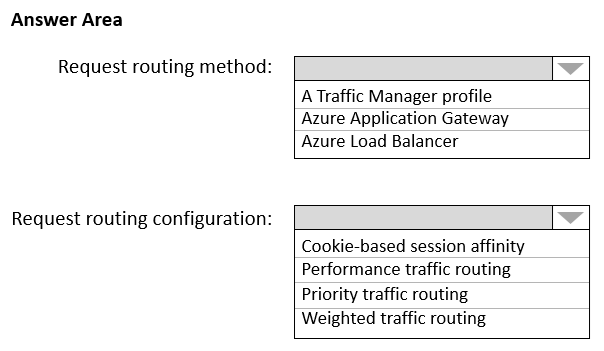
HOTSPOT -
You have an on-premises file server that stores 2 TB of data files.
You plan to move the data files to Azure Blob Storage in the West Europe Azure region.
You need to recommend a storage account type to store the data files and a replication solution for the storage account. The solution must meet the following requirements:
✑ Be available if a single Azure datacenter fails.
✑ Support storage tiers.
✑ Minimize cost.
What should you recommend? To answer, select the appropriate options in the answer area.
NOTE: Each correct selection is worth one point.
Hot Area:
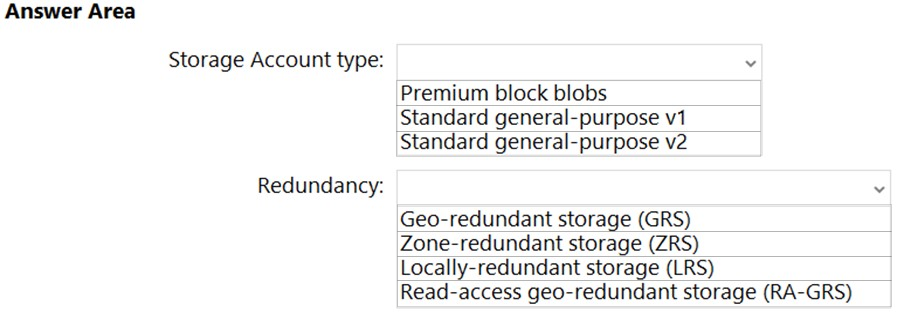
Overview -
Litware, Inc. is a medium-sized finance company that has a main office in Boston.
Existing Environment -
Identity Environment -
The network contains an Active Directory forest named litware.com that is linked to an Azure Active Directory (Azure AD) tenant named litware.com. All users have Azure Active Directory Premium P2 licenses.
Litware has a second Azure AD tenant named dev.litware.com that is used as a development environment.
The litware.com tenant has a Conditional Access policy named Capolicy1. Capolicy1 requires that when users manage the Azure subscription for a production environment by using the Azure portal, they must connect from a hybrid Azure AD-joined device.
Azure Environment -
Litware has 10 Azure subscriptions that are linked to the Litware.com tenant and five Azure subscriptions that are linked to the dev.litware.com tenant. All the subscriptions are in an Enterprise Agreement (EA).
The litware.com tenant contains a custom Azure role-based access control (Azure RBAC) role named Role1 that grants the DataActions read permission to the blobs and files in Azure Storage.
On-Premises Environment -
The on-premises network of Litware contains the resources shown in the following table.
Network Environment -
Litware has ExpressRoute connectivity to Azure.
Planned Changes and Requirements
Planned Changes -
Litware plans to implement the following changes:
Migrate DB1 and DB2 to Azure.
Migrate App1 to Azure virtual machines.
Migrate the external storage used by App1 to Azure Storage.
Deploy the Azure virtual machines that will host App1 to Azure dedicated hosts.
Authentication and Authorization Requirements
Litware identifies the following authentication and authorization requirements:
Only users that manage the production environment by using the Azure portal must connect from a hybrid Azure AD-joined device and authenticate by using
Azure Multi-Factor Authentication (MFA).
The Network Contributor built-in RBAC role must be used to grant permissions to the network administrators for all the virtual networks in all the Azure subscriptions.
To access the resources in Azure, App1 must use the managed identity of the virtual machines that will host the app.
RBAC roles must be applied to management groups.
Resiliency Requirements -
Litware identifies the following resiliency requirements:
Once migrated to Azure, DB1 and DB2 must meet the following requirements:
- Maintain availability if two availability zones in the local Azure region fail.
- Fail over automatically.
- Minimize I/O latency.
App1 must meet the following requirements:
- Be hosted in an Azure region that supports availability zones.
- Be hosted on Azure virtual machines that support automatic scaling.
- Maintain availability if two availability zones in the local Azure region fail.
Security and Compliance Requirements
Litware identifies the following security and compliance requirements:
Once App1 is migrated to Azure, you must ensure that new data can be written to the app, and the modification of new and existing data is prevented for a period of three years.
On-premises users and services must be able to access the Azure Storage account that will host the data in App1.
Access to the public endpoint of the Azure Storage account that will host the App1 data must be prevented.
All Azure SQL databases in the production environment must have Transparent Data Encryption (TDE) enabled.
App1 must NOT share physical hardware with other workloads.
Business Requirements -
Litware identifies the following business requirements:
Minimize administrative effort.
Minimize costs.

After you migrate App1 to Azure, you need to enforce the data modification requirements to meet the security and compliance requirements.
What should you do?A. Create an access policy for the blob service.
B. Implement Azure resource locks.
C. Create Azure RBAC assignments.
D. Modify the access level of the blob service.
Your company, named Contoso, Ltd., implements several Azure logic apps that have HTTP triggers. The logic apps provide access to an on-premises web service.
Contoso establishes a partnership with another company named Fabrikam, Inc.
Fabrikam does not have an existing Azure Active Directory (Azure AD) tenant and uses third-party OAuth 2.0 identity management to authenticate its users.
Developers at Fabrikam plan to use a subset of the logic apps to build applications that will integrate with the on-premises web service of Contoso.
You need to design a solution to provide the Fabrikam developers with access to the logic apps. The solution must meet the following requirements:
✑ Requests to the logic apps from the developers must be limited to lower rates than the requests from the users at Contoso.
✑ The developers must be able to rely on their existing OAuth 2.0 provider to gain access to the logic apps.
✑ The solution must NOT require changes to the logic apps.
✑ The solution must NOT use Azure AD guest accounts.
What should you include in the solution?A. Azure Front Door
B. Azure AD Application Proxy
C. Azure AD business-to-business (B2B)
D. Azure API Management
DRAG DROP
-
You plan to deploy an infrastructure solution that will contain the following configurations:
• External users will access the infrastructure by using Azure Front Door.
• External user access to the backend APIs hosted in Azure Kubernetes Service (AKS) will be controlled by using Azure API Management.
• External users will be authenticated by an Azure AD B2C tenant that uses OpenID Connect-based federation with a third-party identity provider.
Which function does each service provide? To answer, drag the appropriate functions to the correct services. Each function may be used once, more than once, or not at all. You may need to drag the split bar between panes or scroll to view content.
NOTE: Each correct selection is worth one point.

HOTSPOT
-
You have an app that generates 50,000 events daily.
You plan to stream the events to an Azure event hub and use Event Hubs Capture to implement cold path processing of the events. The output of Event Hubs Capture will be consumed by a reporting system.
You need to identify which type of Azure storage must be provisioned to support Event Hubs Capture, and which inbound data format the reporting system must support.
What should you identify? To answer, select the appropriate options in the answer area.
NOTE: Each correct selection is worth one point.

HOTSPOT -
You have the resources shown in the following table.
You create a new resource group in Azure named RG2.
You need to move the virtual machines to RG2.
What should you use to move each virtual machine? To answer, select the appropriate options in the answer area.
NOTE: Each correct selection is worth one point.
Hot Area:
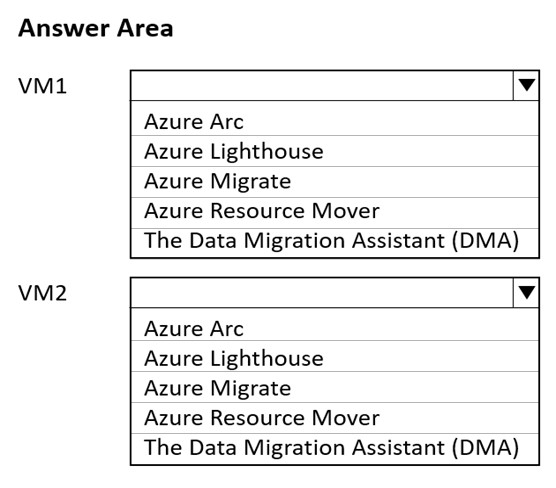
You are developing a sales application that will contain several Azure cloud services and handle different components of a transaction. Different cloud services will process customer orders, billing, payment, inventory, and shipping.
You need to recommend a solution to enable the cloud services to asynchronously communicate transaction information by using XML messages.
What should you include in the recommendation?A. Azure Service Fabric
B. Azure Traffic Manager
C. Azure Queue Storage
D. Azure Notification Hubs
You have data files in Azure Blob Storage.
You plan to transform the files and move them to Azure Data Lake Storage.
You need to transform the data by using mapping data flow.
Which service should you use?A. Azure Databricks
B. Azure Storage Sync
C. Azure Data Factory
D. Azure Data Box Gateway
You are developing a sales application that will contain several Azure cloud services and handle different components of a transaction. Different cloud services will process customer orders, billing, payment, inventory, and shipping.
You need to recommend a solution to enable the cloud services to asynchronously communicate transaction information by using XML messages.
What should you include in the recommendation?A. Azure Service Bus
B. Azure Blob Storage
C. Azure Notification Hubs
D. Azure Application Gateway
HOTSPOT -
You are planning an Azure Storage solution for sensitive data. The data will be accessed daily. The dataset is less than 10 GB.
You need to recommend a storage solution that meets the following requirements:
✑ All the data written to storage must be retained for five years.
✑ Once the data is written, the data can only be read. Modifications and deletion must be prevented.
✑ After five years, the data can be deleted, but never modified.
✑ Data access charges must be minimized.
What should you recommend? To answer, select the appropriate options in the answer area.
NOTE: Each correct selection is worth one point.
Hot Area:
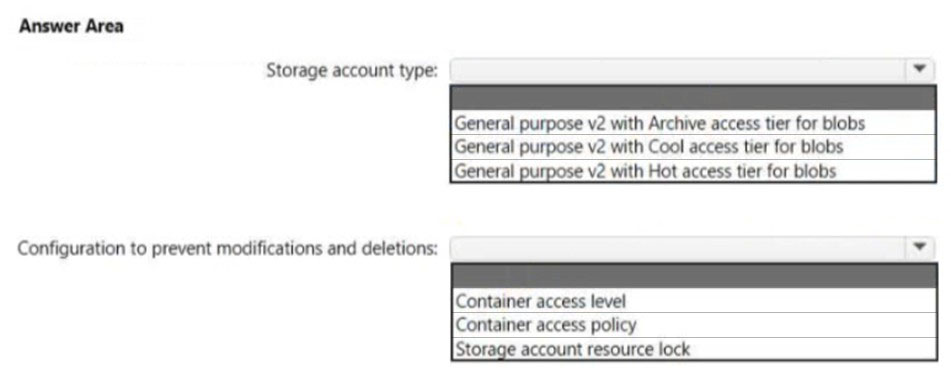
HOTSPOT -
You plan to create an Azure Storage account that will host file shares. The shares will be accessed from on-premises applications that are transaction intensive.
You need to recommend a solution to minimize latency when accessing the file shares. The solution must provide the highest-level of resiliency for the selected storage tier.
What should you include in the recommendation? To answer, select the appropriate options in the answer area.
NOTE: Each correct selection is worth one point.
Hot Area:
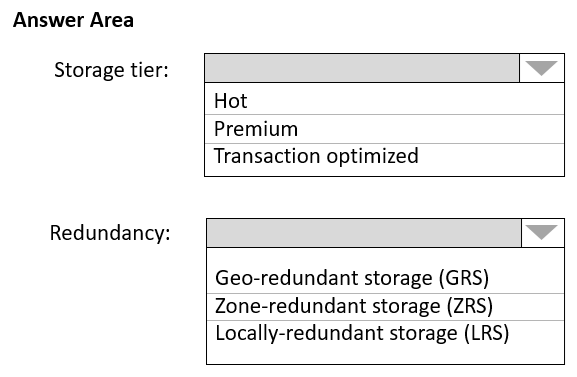
You have an Azure subscription. The subscription has a blob container that contains multiple blobs.
Ten users in the finance department of your company plan to access the blobs during the month of April.
You need to recommend a solution to enable access to the blobs during the month of April only.
Which security solution should you include in the recommendation?A. shared access signatures (SAS)
B. Conditional Access policies
C. certificates
D. access keys
You plan to deploy an Azure Database for MySQL flexible server named Server1 to the East US Azure region.
You need to implement a business continuity solution for Server1. The solution must minimize downtime in the event of a failover to a paired region.
What should you do?A. Create a read replica.
B. Store the database files in Azure premium file shares.
C. Implement Geo-redundant backup.
D. Configure native MySQL replication.
You have an Azure subscription.
Your on-premises network contains a file server named Server1. Server1 stores 5 ׀¢׀’ of company files that are accessed rarely.
You plan to copy the files to Azure Storage.
You need to implement a storage solution for the files that meets the following requirements:
✑ The files must be available within 24 hours of being requested.
✑ Storage costs must be minimized.
Which two possible storage solutions achieve this goal? Each correct answer presents a complete solution.
NOTE: Each correct selection is worth one point.A. Create an Azure Blob Storage account that is configured for the Cool default access tier. Create a blob container, copy the files to the blob container, and set each file to the Archive access tier.
B. Create a general-purpose v1 storage account. Create a blob container and copy the files to the blob container.
C. Create a general-purpose v2 storage account that is configured for the Cool default access tier. Create a file share in the storage account and copy the files to the file share.
D. Create a general-purpose v2 storage account that is configured for the Hot default access tier. Create a blob container, copy the files to the blob container, and set each file to the Archive access tier.
E. Create a general-purpose v1 storage account. Create a fie share in the storage account and copy the files to the file share.
HOTSPOT
-
Your on-premises network contains an Active Directory Domain Services (AD DS) domain. The domain contains a server named Server1. Server1 contains an app named App1 that uses AD DS authentication. Remote users access App1 by using a VPN connection to the on-premises network.
You have an Azure AD tenant that syncs with the AD DS domain by using Azure AD Connect.
You need to ensure that the remote users can access App1 without using a VPN. The solution must meet the following requirements:
• Ensure that the users authenticate by using Azure Multi-Factor Authentication (MFA).
• Minimize administrative effort.
What should you include in the solution? To answer, select the appropriate options in the answer area.
NOTE: Each correct selection is worth one point.

Access Full AZ-305 Mock Test Free
Want a full-length mock test experience? Click here to unlock the complete AZ-305 Mock Test Free set and get access to hundreds of additional practice questions covering all key topics.
We regularly update our question sets to stay aligned with the latest exam objectives—so check back often for fresh content!
Start practicing with our AZ-305 mock test free today—and take a major step toward exam success!


